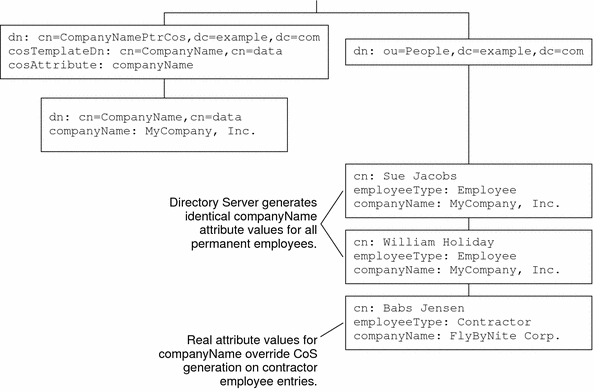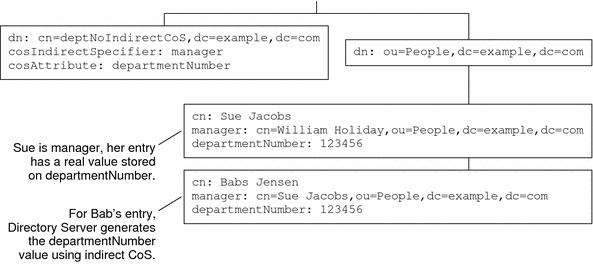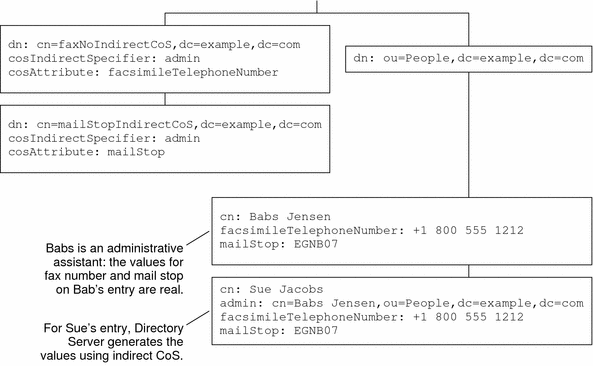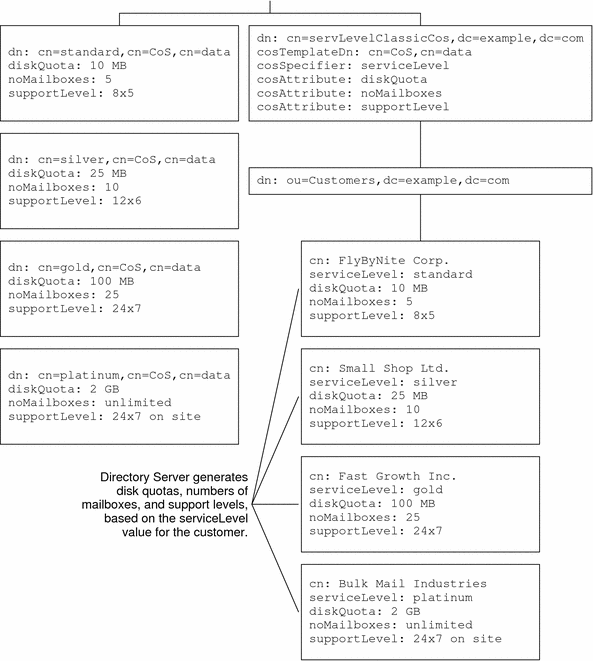Grouping Directory Entries and Managing Attributes
The directory information tree organizes entries hierarchically. This hierarchy is a type of grouping mechanism. The hierarchy is not well suited for associations between dispersed entries, for organizations that change frequently, or for data that is repeated in many entries. Directory Server groups and roles offer more flexible associations between entries. The class of service (CoS) mechanism enables you to manage attributes so that the attributes are shared between entries. This sharing is done in a way that is invisible to applications.
These entry grouping and attribute management mechanisms are described in detail in Chapter 8, Directory Server Groups and Roles, in Sun Java System Directory Server Enterprise Edition 6.0 Reference and in Chapter 9, Directory Server Class of Service, in Sun Java System Directory Server Enterprise Edition 6.0 Reference.
This section provides an overview of the grouping mechanisms that is sufficient to design an administrative strategy. It does not explain how the mechanisms work or how to set them up.
The section is divided into the following topics:
Static and Dynamic Groups
Directory Server distinguishes between two types of groups:
-
Static groups. Explicitly name their member entries.
-
Dynamic groups. Specify a filter and all entries that match the filter are members of the group. These groups are dynamic because membership is defined each time the filter is evaluated.
Managed, Filtered, and Nested Roles
Roles are an entry grouping mechanism. Roles enable you to determine role membership as soon as an entry is retrieved from the directory. Each role has members, or entries that possess the role. As with groups, you can specify role members explicitly or dynamically.
Directory Server supports the following three types of roles:
-
Managed roles. Explicitly assign a role to member entries.
-
Filtered roles. Automatically make entries members if the entries match a specified LDAP filter. In this way, the role depends on the attributes contained in each entry.
-
Nested roles. Enable you to create roles that contain other roles.
Deciding Between Groups and Roles
The functionality of the groups and roles mechanisms overlap somewhat. Both mechanisms have advantages and disadvantages. Generally, the roles mechanism is designed to provide frequently required functionality more efficiently. Because the choice of a grouping mechanism influences server complexity and determines how clients process membership information, you must plan your grouping mechanism carefully. To decide which mechanism is more suitable, you need to understand the typical membership queries and management operations that are performed.
Advantages of the Groups Mechanism
Groups have the following advantages:
-
Static groups are the only standards-based grouping mechanism. Static groups are therefore interoperable with most client applications and LDAP servers.
-
Static groups are preferable to roles for enumerating members.
If you only need to enumerate members of a given set, static groups are less costly. Enumerating members of a static group by retrieving the member attribute is easier than recovering all entries that share a role. In Directory Server 6.0, significant performance improvements have been made for large multi-valued attributes. Equality matching and modify operations on these attributes are greatly improved, specifically in relation to static groups. Membership testing for group entries has also been improved. These improvements remove some of the previous restrictions on static groups, specifically the restriction on group size.
Directory Server 6.0 also provides group membership directly in user entries, with the isMemberOf operational attribute. This feature applies to static groups only but includes nested groups. For more information, see Managing Groups in Sun Java System Directory Server Enterprise Edition 6.0 Administration Guide.
-
Static groups are preferable to roles for management operations such as assigning and removing members.
Static groups are the simplest mechanism for assigning a user to a set or removing a user from a set. Special access rights are not required to add the user to the group.
The right to create the group entry automatically gives you the right to assign members to that group. This is not the case for managed and filtered roles. In these roles, the administrator must also have the right to write the nsroledn attribute to the user entry. The same access right restrictions also apply indirectly to nested roles. The ability to create a nested role implies the ability to pull together other roles that have already been defined.
-
Dynamic groups are preferable to roles for use in filter-based ACIs.
If you only need to find all members based on a filter, such as for designating bind rules in ACIs, use dynamic groups. Although filtered roles are similar to dynamic groups, filtered roles trigger the roles mechanism and generate the virtual nsRole attribute. If your client does not need the nsRole value, use dynamic groups to avoid the overhead of this computation.
-
Groups are preferable to roles for adding or removing sets into or from existing sets.
If you want to add a set to an existing set, or remove a set from an existing set, the groups mechanism is simplest. The groups mechanism presents no nesting restrictions. The roles mechanism only allows nested roles to receive other roles.
-
Groups are preferable to roles if flexibility of scope for grouping entries is critical.
Groups are flexible in terms of scope because the scope for possible members is the entire directory, regardless of where the group definition entries are located. Although roles can also extend their scope beyond a given subtree, they can only do so by adding the scope-extending attribute nsRoleScopeDN to a nested role.
Advantages of the Roles Mechanism
Roles have the following advantages:
-
Roles are preferable to dynamic groups if you want to enumerate members of a set and find all sets of which a given entry is a member. Static groups also provide this functionality with the isMemberOf attribute.
Roles push membership information out to the user entry where this information can be cached to make subsequent membership tests more efficient. The server performs all computations, and the client only needs to read the values of the nsRole attribute. In addition, all types of roles appear in this attribute, allowing the client to process all roles uniformly. Roles can perform both operations more efficiently and with simpler clients than is possible with dynamic groups.
-
Roles are preferable to groups if you want to integrate your grouping mechanism with existing Directory Server functionality such as CoS, Password Policy, Account Inactivation, and ACIs.
If you want to use the membership of a set “naturally” in the server, roles are a better option. This implies that you use the membership computations that the server does automatically. Roles can be used in resource-oriented ACIs, as a basis for CoS, as part of more complex search filters, and with Password Policy, Account Inactivation, and so forth. Groups do not allow this kind of integration.
Restricting Permissions on Roles
Be aware of the following issues when using roles:
-
The nsRole attribute can only be assigned by the roles mechanism. While this attribute cannot be assigned or modified by any directory user, it is potentially readable by any directory user. Define access controls to keep this attribute from being read by unauthorized users.
-
The nsRoleDN attribute defines managed role membership. You need to decide whether users can add or remove themselves from the role. To keep from modifying their own roles, you must define an ACI to that effect.
-
Filtered roles determine membership through filters that are based on the existence or the values of attributes in user entries. Assign the user permissions of these attributes carefully to control who can define membership in the filtered role.
Managing Attributes With Class of Service
The Class of Service (CoS) mechanism allows attributes to be shared between entries. Like the role mechanism, CoS generates virtual attributes on the entries as the entries are retrieved. CoS does not define membership, but it does allow related entries to share data for coherency and space considerations. CoS values are calculated dynamically when the values are requested. CoS functionality and the various types of CoS are described in detail in the Sun Java System Directory Server Enterprise Edition 6.0 Reference.
The following sections examine the ways in which you can use the CoS functionality as intended, while avoiding performance pitfalls:
Note –
CoS generation always impacts performance. Client applications that search for more attributes than they actually need can compound the problem.
If you can influence how client applications are written, remind developers that client applications perform much better when looking up only those attribute values that they actually need.
Using CoS When Many Entries Share the Same Value
CoS provides substantial benefits for relatively low cost when you need the same attribute value to appear on numerous entries in a subtree.
Imagine, for example, a directory for MyCompany, Inc. in which every user entry under ou=People has a companyName attribute. Contractors have real values for companyName attributes on their entries, but all regular employees have a single CoS-generated value, MyCompany, Inc., for companyName. The following figure demonstrates this example with pointer CoS. Notice that CoS generates companyName values for all permanent employees without overriding real, not CoS-generated, companyName values stored for contractor employees. The company name is generated only for those entries for which companyName is an allowed attribute.
Figure 8–6 Generating CompanyName With Pointer CoS

In cases where many entries share the same value, pointer CoS works particularly well. The ease of maintaining companyName for permanent employees offsets the additional processing cost of generating attribute values. Deep directory information trees (DITs) tend to bring together entries that share common characteristics. Pointer CoS can be used in deep DITs to generate common attribute values by placing CoS definitions at appropriate branches in the tree.
Using CoS When Entries Have Natural Relationships
CoS also provides substantial data administration benefits when directory data has natural relationships.
Consider an enterprise directory in which every employee has a manager. Every employee shares a mail stop and fax number with the nearest administrative assistant. Figure 8–7 demonstrates the use of indirect CoS to retrieve the department number from the manager entry. In Figure 8–8, the mail stop and fax number are retrieved from the administrative assistant entry.
Figure 8–7 Generating DepartmentNumber With Indirect CoS

In this implementation, the manager’s entry has a real value for departmentNumber, and this real value overrides any generated value. Directory Server does not generate attribute values from CoS-generated attribute values. Thus, in the Figure 8–7 example, the department number attribute value needs to be managed only on the manager's entry. Likewise, for the example shown in Figure 8–8, mail stop and fax number attributes need to be managed only on the administrative assistant’s entry.
Figure 8–8 Generating Mail Stop and Fax Number With Indirect CoS

A single CoS definition entry can be used to exploit relationships such as these for many different entries in the directory.
Another natural relationship is service level. Consider an Internet service provider that offers customers standard, silver, gold, and platinum packages. A customer’s disk quota, number of mailboxes, and rights to prepaid support levels depend on the service level purchased. The following figure demonstrates how a classic CoS scheme enables this functionality.
Figure 8–9 Generating Servic-Level Data With Classic CoS

One CoS definition might be associated with multiple CoS template entries.
Avoiding Excessive CoS Definitions
Directory Server optimizes CoS when one classic CoS definition entry is associated with multiple CoS template entries. Directory Server does not optimize CoS if many CoS definitions potentially apply. Instead, Directory Server checks each CoS definition to determine whether the definition applies. This behavior leads to performance problems if you have thousands of CoS definitions.
This situation can arise in a modified version of the example shown in Figure 8–9. Consider an Internet service provider that offers customers delegated administration of their customers’ service level. Each customer provides definition entries for standard, silver, gold, and platinum service levels. Ramping up to 1000 customers means creating 1000 classic CoS definitions. Directory Server performance would be affected as it runs through the list of 1000 CoS definitions to determine which apply. If you must use CoS in this sort of situation, consider indirect CoS. In indirect CoS, customers’ entries identify the entries that define their class of service allotments.
When you start approaching the limit of having different CoS schemes for every target entry or two, you are better off updating the real values. You then achieve better performance by reading real, not CoS-generated values.
- © 2010, Oracle Corporation and/or its affiliates
